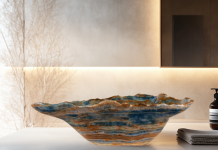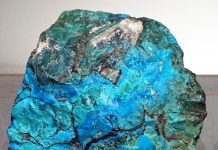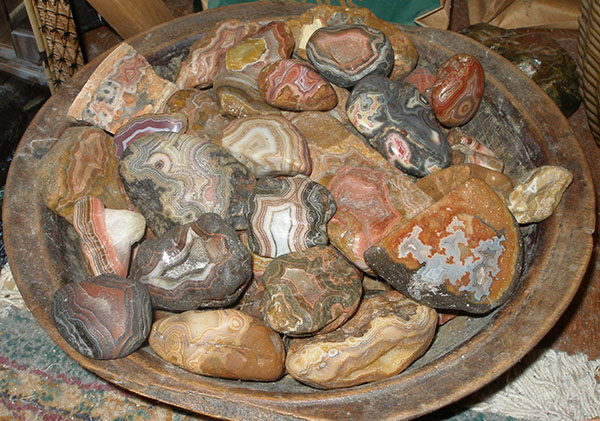
Story and Photos by Kathleen Fink
With so many rocks finding their way into our homes, it is not surprising that many collectors face the dilemma of what to do with them all. The good news is that finding solutions can be a very rewarding aspect of the hobby. Just as a garden reflects the personality and desires of its creator, what we do with the rocks we collect is a highly personal matter.
Throughout history, people have gathered rocks for practical and spiritual uses and for their aesthetic appeal. Specimens have bestowed status and have been acquired as investments. Those with scientific knowledge regarding their composition and genesis tend to find all the more reason to appreciate them.
While a child may be happy to keep finds in a cardboard egg carton, serious collectors have been known to commission beautiful, carved stands or to line entire rooms with lighted display cabinets. When aesthetic effect is a primary motivation, collectors may display these natural sculptures prominently on various surfaces in their homes. Carefully organized collections find their way into bookcases, cabinets, and many types of display cases. Add labels indicating type and other information, and a collection can move in the direction of becoming a private museum.
Collectors have found any number of creative ways to display their rocks: beneath glass tabletops, wire wrapped into rain chains, sewn into tapestries, and secured to various backings, including fireplace surrounds. Natural pebbles and carved rocks are used as playing pieces in games all around the world. Artists stack rocks into spectacular configurations or carve them into pleasing shapes. Burbling “rock music” results when stones are placed in fountains.
Slabs are placed in windows as suncatchers, incorporated into stained glass-type windows and lampshades, and hung on wind chimes and mobiles. Slabs and cabochons are framed and hung on walls, while shadow boxes accommodate thicker specimens. When not being worn, jewelry containing special stones may be displayed in a variety of ways, including on elaborate custom stands.
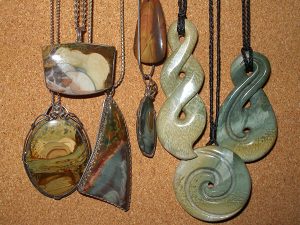
Overflow rock specimens can be moved outdoors, placed along foundations, in planters, and in piles on decks and patios. When truly abundant, rocks are sometimes stored in crates lined up out back or are locked into wooden sheds.
Of course, some rocks are intended for the outdoors in the first place. They find homes in rock gardens—traditional or eccentric—walls and paths. They are important elements in many Asian gardens. Placing beautiful rocks in our yards and even on balconies can provide much lasting pleasure.
Photos can stand in for space-consuming and often valuable rocks that are stored out of the way and taken out from time to time, as desired. The visual appreciation developed in building a rock collection is directly applicable to taking rock portraits. Even beginners can achieve good results outdoors in natural light.
While photos do not convey the tactile qualities of rocks, they can be excellent, clear, and close-up visual representations. The photographer’s ability to perfectly position and light a rock influences our ability to appreciate it, and details are more visible and striking in enlargements. A well-respected rock photographer told me that his clients often say they prefer the photo to the rock itself. Digital super-macro technology now allows us to produce spectacular close-ups. A camera with this capability provides a whole new way to explore a collection that can produce surprises, as well as many artful images.
Photos, of course, are excellent for sharing. Calendars, cards, and other items with rock portraits make inspiring gifts. Enlargements and close-ups may be hung on walls. Booklets bound in inexpensive report covers serve as a way to share field trip stories and finds. A growing number of online forums with international audiences provide communities for sharing images and comments. For experts who write about their collections, crisp, high-resolution images are a must. Everyone wants to see prime examples, whether on a website or in a blog, book, or Rock & Gem article.
Professional photographers who specialize in taking photos of others’ specimens make their “collection” the whole world of beautiful and interesting rocks. It is important to respect their talents, as well as their often considerable investment in training, time and equipment, by obtaining permission before using their images for any purpose.
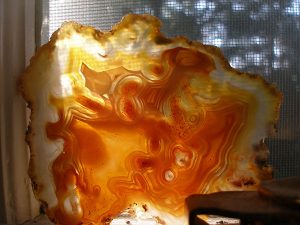
Organized collectors use photos to help document their collections so that important information is not lost. Having a photo, together with such information as the date acquired, mineral type, dimensions, location of origin (if known), features of note, and the seller’s name and purchase price (if applicable), can prove invaluable for any number of purposes.
More than a few successful businesses started when collectors found a need to cull less desirable rocks from their growing collections. Those in the business of selling rocks may or may not have large collections of their own. After all, they get to enjoy a steady stream of desirable rocks passing through their hands, and in most cases they keep photographic records of their ever-changing inventory.
In my experience, a collection and the way it is displayed tend to evolve over time. As a child, I liked picking up natural rocks and playing with them in my room. My formal collecting began many years ago when my brother gave me a chunk of multicolor tourmaline.
I found a shop that carried tourmaline near where my family camped during the summers, in the White Mountains of New Hampshire. As I came to desire better crystals, and as tourmaline prices in general rose, my collecting slowed considerably. I found a wooden spice rack with clean lines that holds my specimens to this day, with the exception of one larger specimen with blue and pink crystals penetrating quartz.
My rock collecting really took off when I discovered the world of agate and jasper. I remember doing an internet search on the word “agate” just to see what would come up. Living in New England, I was not familiar with their diversity and amazing colors, and I was immediately entranced. I studied websites, read books and articles, and reached out to experts with questions.
As I began to make friends in the business, I was invited to visit locations where some of the types I loved were found. My vacations also began to include shows and special agate symposia. Of course, I always brought back a few souvenirs. Happily addicted, I had acquired incredible friendships, as well as a growing collection of agates and jasper.
By luck, I happened to purchase a stack of large, old wooden bowls. I thought they were all the more beautiful for having been knocked about a bit and having survived a fire. When I bought the bowls, I had no specific plans for their use. It did not take long for me to realize, however, that they would be a good size to hold the various types of agate I collect, reducing visual clutter at the same time.
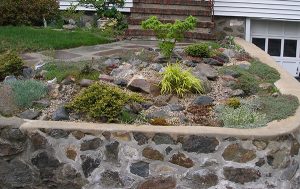
When I tried placing my Fairburn agates in one of the bowls, the immediate impression was one of sensuality, warmth, and vibrant energy. I could better sense the spirit of Fairburn agates by taking in at one glance all the contrasts and similarities before me. I also sensed things going on that are difficult to put into words, but I was aware that stones related to their neighbors in interesting ways. I knew I was also seeing a reflection of my particular tastes and the forces that combined to allow me to collect those particular examples.
Arranging agates to my liking in those bowls turned out to be a time-consuming process of trial and error. I would prop individual agates against each other with their preferred faces up, while simultaneously balancing size, shape, pattern and color. I found this totally absorbing and quite satisfying, but I understand that others might find it a frustrating waste of time. Of course, there is no reason not to let rocks fall where they may into a bowl, an approach I used for tumble-polished jasper pebbles, with good results.
For some reason, my cat preferred the bowl of Fairburn agates. I would sometimes catch her with an intent look on her face, reaching in a paw to pull one out. I do not think she was simply dropping them to get my attention, as she seemed genuinely fascinated. Golda was careful not to disturb the remaining stones when she removed one, but woe betide the person who reaches carelessly into one of my painstaking arrangements.
I started to collect agate and jasper cabochons when I became aware of how well they frame delightful images without taking up much space. They often have distinctive personalities that I attribute in part to the lapidary artist’s choices. At one time, I had many of them mingling at a “cab convention” on my computer table. I have mixed feelings about exiling most of these cabochons to storage, but I am happier without their constant squabbling with one another for attention.
At the same time as I was engaged with the lively agates and jasper, my appreciation for ordinary rocks, especially those with beautiful weathered shapes, found a focus outdoors. The house we purchased has an exposed granite mound resembling a large turtle in the backyard. The bedrock that makes up much of the vicinity has collected our neighbors and us more than we have collected it, but I certainly appreciate the sense of deep time it conveys with its glacial scrape marks and coating of lichens.
As soon as I saw the view through the large kitchen window, I recognized the potential for a garden with a Japanese flavor. All that was needed by way of additional rockwork was a stepping stone path and a few small, ancillary rocks. When we replaced a retaining wall out front, I had an excuse to gather natural rocks and gravel for a rock garden. Some pieces of jasper rough made their way out to that garden, where it seemed to settle in quite well.
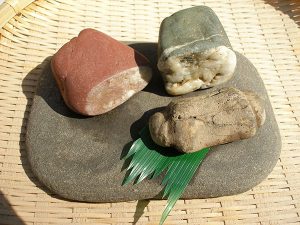
I saw what looked like a natural, hut-shaped stone on a stand in a business’ window, and suspected my chances of finding one for sale were not good. Again, I turned to the internet, read books, and became friends with an expert. I had discovered the world of viewing stones. These natural stones are collected in a number of categories by shape; they may resemble animals or natural features like mountains and waterfalls, or have beautiful abstract shapes. They have a long tradition in China and Japan, where they are often displayed on beautifully carved wooden stands or in ceramic trays filled with sand or water. A growing group of enthusiasts in many countries find suitable stones in their own streams and mountains.
Although evocative viewing stones can be incredibly diverse as well as remarkably beautiful, I found that I was satisfied with a limited number. I find they have a large impact for their size, which can range from an inch to over 5 feet tall in the case of those found in Chinese gardens and in front of the Boston Museum of Fine Arts. Mine reside indoors on windowsills, on a wall shelf above my computer monitor, and even on top of the refrigerator. Two wooden stands with asymmetrically arranged shelves hold small ones, including some agate and jasper examples.
Over the years, I have been fortunate to visit collectors and see a wide variety of display approaches, from the resolutely functional to the highly creative. Regardless of the strategy used, rocks repay the attention and care taken with their display, as well as with the photos that represent them. As natural objects, there is always a freshness about rocks. They have the power to take our focus away from day to day irritations with their enduring mystery and beauty.
The rocks themselves, as well as the relationships and learning that go hand in hand with collecting, can add great richness to life. It is now my great pleasure to inspire others to collect rocks and to find their own ways to display and share them. I recently gave a framed poster of agates to a young boy, knowing that this might start him down the road to this rewarding hobby. As he left, the boy’s father told me his son had asked how soon they could go to the beach so he could get some rocks.



